Summer 2016 Law Library
Reading List
“We don’t need a list of rights and wrongs, tables of dos and don’ts: we need books, time, and silence. Thou shalt not is soon forgotten, but Once upon a time lasts forever.” — Philip Pullman
We don’t know about you, but we think it’s been a longgggg year. It’s time to kick back and relax. Enjoy.
The UC Berkeley School of Law Library
- A True Novel (Honkaku Shosetsu) by Minae Mizumura
- Attachments by Rainbow Rowell
- The Bamboo Sword by Margi Preus (Ages 10-15)
- Better Call Saul - television legal/crime drama series
- Between the World and Me by Ta-Nehisi Coates
- Carry On by Rainbow Rowell (YA)
- Charlie and the Chocolate Factory by Roald Dahl (Ages 9-12)
- City on Fire by Garth Risk Hallberg
- Dark Money by Jane Mayer
- Debrett's Guide for the Modern Gentleman by Tom Bryant
- Eligible: A Modern Retelling of Pride and Prejudice by Curtis Sittenfeld
- Evicted: Poverty and Profit in the American City by Matthew Desmond
- Furiously Happy by Jenny Lawson
- Girl in the Dark by Marian Pauw
- Introducing the Honourable Phryne Fisher. Cocaine Blues; Flying Too High; Murder on the Ballarat Train by Kerry Greenwood
- Johnny Tremain by Esther Forbes (Ages 11-13)
- Kingbird Highway: The biggest year in the life of an extreme birder by Kenn Kaufman and Lab Girl by Hope Jahren
- My Kitchen Year: 136 Recipes that Saved my Life by Ruth Reichl
- Practical Criticism: A Study of Literary Judgment by I.A. Richards
- The Raven Boys by Maggie Stiefvater
- Roller Girl by Victoria Jamieson (Grades 5-8)
- Seven Brief Lessons in Physics by Carlo Rovelli
- Tangled Vines: Greed, Murder, Obsession, and an Arsonist in the Vineyards of California by Frances Dinkelspiel
- The Warmth of Other Suns: The Epic Story of America's Great Migration by Isabel Wilkerson

A True Novel (Honkaku Shosetsu)
by Minae Mizumura
Kathryn HashimotoCopyright Research Fellow, Berkeley Center for Law & Technology
Mizumura’s novel, originally published in 2002 and translated into English by Juliet Winters Carpenter in 2013, is an entertaining re-telling of the Wuthering Heights story, updated and set primarily in Japan just before and following World War II. In addition to recalling the gothic romanticism of Emily Bronte’s classic love story (Catherine and Heathcliff become Yoko and Taro), the novel offers interesting insight into Japanese class and social upheaval in the modern period. It also depicts the western influence on Japanese culture and identity, setting part of the story in Karuizawa, a mountain resort town known for western-style buildings where both Japanese and foreign elite resided to escape the summer heat, and in its description of Taro’s Gatsby-like rise in fortune in the U.S.
On a lit crit level, A True Novel explores narrative forms in Japanese fiction as they reflect themes of truth and subjectivity. With a slight twist at the end, the novel calls into question the credibility and motivations that underlie the stories that characters (and writers) tell.
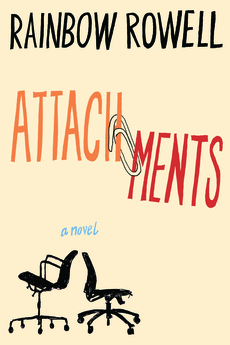
Attachments
by Rainbow Rowell
Edna LewisReference Librarian
Rainbow Rowell is one of my all time favorite YA authors (Eleanor and Park, FanGirl), and I am jazzed to report that Attachments, her second foray into adult fiction, is an absolute delight. Let me begin by saying that it was a relief to read a novel about contemporary twenty-somethings that wasn’t set in Brooklyn or Silver Lake (get over yourselves you self-important urban hipsters). Instead, in this charming You’ve Got Mail type sendup, Lincoln, perpetual grad student, still living with mom, is hired as a computer security monitor for a Nebraska newspaper (yes, a newspaper!). While monitoring email communications he happens upon the ongoing correspondence between Beth, the newspaper’s movie critic, and Jennifer, a copy editor, both also in their late twenties. Beth has a live in rocker boyfriend who never wants to be married and Jennifer a sturdy high school band director husband whose biological clock is sending out baby alarms while she just isn’t feeling it. Lincoln knows their emails often violate company policy, but he can’t turn them in and can’t stop reading as he is increasingly smitten with Beth. Lincoln, a big shuffling nerd, who happily plays Dungeons and Dragons on Saturday nights with his pals, gradually becomes more engaged in life while finally outgrowing a youthful broken romance that has stunted his adulthood. Beth and Jennifer both suffer heartbreaks. Even as you keep telling yourself it will work out, it will work out, a series of missed communications, missed connections, and Lincoln’s ongoing guilt about his secret voyeurism jack up the tension and threaten to sabotage the happy ending.
Funny, quirky, captivating - this one shouts Summer Read. Don’t overthink it.

The Bamboo Sword
by Margi Preus (Ages 10-15)
Jacob Klein6th Grade, Fairmont Elementary School, El Cerrito
Black Ships from America are invading Edo Bay. No one can enter the country, so Japanese samurai prepare for a war against the “hairy barbarians”. Yoshi, a thirteen-year-old Japanese servant dreams to fight against the “white devils”. Since he is only a peasant, it is illegal for him to carry swords or become a samurai. Hideki, Yoshi’s kendo teacher is too afraid to go to battle, so he and Yoshi switch clothes. Yoshi’s dreams of becoming a samurai and going to battle are on the verge of coming true. When he is forced to flee, he runs into a samurai named Manjiro, who is going to Edo to tell the shogun about the outsiders. Many people suspect Manjiro is an American spy, and that he should not be trusted because he supposedly is responsible for bringing the foreign ships to Edo Bay. He teaches Yoshi some American concepts, like how to use a lasso and how to shake hands.
Jack, a thirteen-year-old cabin boy, is aboard the Susquehanna, an American ship that is invading the Japanese shores. He takes orders from everyone. He is among the first Americans to go ashore Japan. Every few chapters, the narrator switches, from Yoshi’s to Jack’s then back to Yoshi’s. In my opinion, it makes the story seem more interesting.
Near the end of the story, Jack and Yoshi meet. They become really good friends and have many adventures together. When Yoshi takes Jack to Edo, he makes sure that his friend is disguised so nobody would find out that he is an outsider. Seven years later, Jack and Yoshi unexpectedly meet on an American boat. They exchange gifts and leave each other forever.
I really enjoyed reading the book because I felt like I was there, feeling what Yoshi and Jack were feeling and experiencing what they experienced. I would recommend this book to people aged 10 to 15 because of its complicated sentence structure and advanced vocabulary.

Better Call Saul
television legal/crime drama series
Annelise MissbachCataloging
After you’ve finished studying or teaching the law for the semester or, as in my case, take leave of updating some very old catalog call numbers into present-day Library of Congress classifications for the last 18 years, you might not want to look at another book for the next few months?
Thank God, there is a solution for you to keep those fancy legal jargons and dealings front and center, consider job opportunities in Albuquerque, contemplate a criminal legal career (crime pays!) and get comic relief all at the same time!
“Better Call Saul” is plugged as an American television legal crime series and a spin-off prequel to “Breaking Bad” (had to digest that one), and was co-created by Vince Gillian and Peter Gould. Jimmy McGill, a cunning small time lawyer with a shady past and a less than prestigious correspondence degree from a law school located in American Samoa, desperately hustles to make a “legal” living as a public defender from the back office in a Vietnamese nail salon in Albuquerque. It’s amusing to watch “Slippin’ Jimmy” trying to make deals with the state prosecutor or finagle anything he can get. There is something compelling about his desperation and he makes it clear that you can’t hustle a hustler, thus he gets himself into all kinds of delightful and sometimes scary trials and tribulations. So badly he wants to play with the big boys that he falls in with some questionable characters and, according to rumors, will eventually transform into being teacher-turned meth cooker Walter White’s lawyer Saul Goodman on “Breaking Bad”. Hopefully we shall see in season 3.
Indulge yourself in front of the screen with a cold one and watch “Better Call Saul”. BTW, you can still enjoy it without having first seen “Breaking Bad”. I did.
If you haven’t seen it, we have the complete “Breaking Bad” series in the Law Library’s DVD collection and will soon be adding “Better Call Saul.”
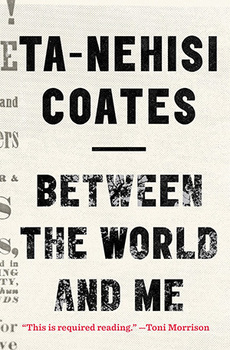
Between the World and Me
by Ta-Nehisi Coates
Amy UtsteinDirector of Administration
In this series of essays, written as letters to his teenaged son, Coates powerfully and provocatively addresses issues of race in America. Coates won the National Book award for Between the World and Me and it's clear to see why. This memoir is an important read and not to be missed.
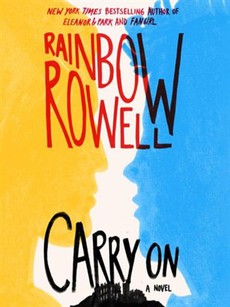
Carry On
by Rainbow Rowell (YA)
Fiona LewisSenior, The Bentley School
Carry On by Rainbow Rowell might seem at first to be just another Harry Potter fan fiction knockoff - but it is so much more than that. The work is the expansion to an actual book of the fan fiction the main character wrote in Rowell's YA novel, Fangirl (also a great book). Carry On is funny and relatable in a way that many fantasy novels and certainly most fan fiction are not. The story takes place at a wizard boarding school where the 2 roommates, Simon Snow/The Chosen One and Baz/The Evil Vampire (read Harry Potter/Draco Malfoy) are in their final year of trying to kill each other. The narrative shifts perspectives among characters (including Penelope, a Hermione knockoff) in a way that completely immerses the reader in the mystery, the love story, and the peculiar universe in which the story is set. The characters constantly refer to things that have already happened in prior school years as if it were the 5th book in the series, not the first. The spells are hilarious takeoffs on contemporary culture - If you say "Can you hear me now?" it makes people deaf. If you say "Call me maybe" the person will have an uncontrollable need to call you on the phone. It's a whole universe packed into one well written book. It may be inspired by Harry Potter, but it’s completely original.
Well done, I say.

Charlie and the Chocolate Factory
by Roald Dahl (Ages 9-12)
Leah Klein3d Grade, Fairmont Elementary School, El Cerrito
Charlie and the Chocolate Factory by Roald Dahl is about a boy named Charlie Bucket. His family is very poor. He lives with his Grandpa Joe, Grandma Josephine, Grandpa George, Grandma Georgina and mom and dad. He loves chocolate a lot and the only time he gets a chocolate bar is on his birthday. His dad read the newspaper and it said “WONKA FACTORY TO BE OPENED AT LAST TO LUCKY FEW”. There were five golden tickets hidden in Wonka Bars and the people who find them get to go to Mr. Willy Wonka’s Chocolate Factory. Charlie finds a dollar bill and buys two Wonka Bars. In the second bar he finds a golden ticket!
Charlie and his Grandpa Joe go to Mr. Willy Wonka’s Chocolate Factory. The other winners are Augustus Gloop, Violet Beauregarde, Veruca Salt and Mike Teavee. August Gloop eats a ton. Violet Beauregarde chews gum all the time. Veruca Salt is super spoiled. Mike Teavee’s eyes are glued to the TV. The five children meet Mr. Willy Wonka and go into the chocolate factory. Mr. Willy Wonka has a high fluttery voice, wears a top hat, has a goatee, and is eager to show off his factory. The factory is awesome and really cool. There are separate rooms for each kind of candy. There is a chocolate river and chocolate waterfall. There is an inventing room with a great gum machine. The secret workers are Oompa Loompas who are very short, have funny long hair, and sing a lot.
During the tour all the kids except Charlie get into mischief. For example, Augustus Gloop sneaks down to the chocolate river and gulps the chocolate. He isn’t supposed to. He falls in, almost drowns because he can’t swim! Then he gets sucked up a pipe. Charlie is the only child that behaves. He thinks the chocolate factory is wonderful.
At the end of the book Charlie gets an amazing prize, which I’m not going to tell you about because you have to read the book! This is one of my favorite Roald Dahl books. There are lots of interesting parts and I like the characters of Charlie, his family and Mr. Willy Wonka.

City on Fire
by Garth Risk Hallberg
Ellen GilmoreReference Librarian
Over the years the library’s Reading List has included audiobooks, children’s books, cookbooks, self-help books, and even suggestions of books NOT to read. I’m going to add a new category - very long books. City on Fire is a 900+ page novel, but please don’t be scared away. What better time than summer vacation to immerse yourself in an expansive, ambitious, multi-character drama. This one takes place in New York City between Christmas 1976 and July 13, 1977, the day of the famous New York blackout. The author was given a headline-making advance of $2 million for this book, much hype preceded its release, and movie and TV rights were snapped up. While it didn’t turn out to be the blockbuster Great American Novel of 2015, it’s a fascinating portrait of New York at a time when the city was crime and graffiti-ridden, its finances in crisis, and its infrastructure badly in need of repair. The intricately plotted narrative, which includes an attempted murder in Central Park, is precisely written and easy to read but complicated to describe. To give you a flavor, the story involves a cross-section of characters including suburban teenagers, a wealthy and powerful New York family, a black gay would-be novelist, a seen-it-all police detective, an investigative journalist, a fireworks expert, punks, artists, musicians, and drug addicts. As one critic imagined, “I picture the walls of Hallberg’s New York apartment so covered with pushpins that they distort the Earth’s magnetic field”.
The author’s vocabulary is vast, and every sentence of this novel is well-written. The period details are a lot of fun, especially if you lived through those years. My favorite trip down memory lane: “In the broad and average middle of broad and average Long Island, 1976 had been the year of apres-ski. The idea was to look like you’d tackled a slalom course on the way to school: acrylic sweaters and knit caps and quilted down jackets with lift-passes clipped to the zippers.”
The 94 chapters are each a perfect length to make the book approachable. Every chapter changes character and perspective, so it’s easy to either binge read this book or to take it in short doses. It’s kind of like watching TV today, and in fact The Atlantic magazine compared the novel’s structure to HBO-type dramas in its episodic nature, characterization, and length. Why not turn off the tube for a while and lose yourself in this captivating novel.

Dark Money
by Jane Mayer
Robert C. Berring, Jr.Walter Perry Johnson Professor of Law
This book chronicles the manner in which the Koch brothers, and a band of billionaires with whom they associate, have imposed their will on the American political scene. Charles Koch does not want anyone to tell him what to do. The only entity left that can do so is the federal government and therefore he hates it. Because Mayer is careful to document each thing she says, the book can grow tedious, but it is powerful. The audacity of some of the things that have been done is breathtaking. And many of the plans have worked quite well. They cannot seem to solve the challenge of electing a President but they have control of many state legislatures and the Congress so they need not worry. Powerful and scary.

Debrett's Guide for the Modern Gentleman
by Tom Bryant
Joseph CeraLegal Research Librarian for Information Technology & Scholarly Communications
Our style and manners are typically molded as we grow and become more aware of the world around us. Men basically wear variations on the same things when it comes to style. This means that you need to find small details to set yourself apart. This book has a lot of good advice and guidance for topics that you have never even considered. Know your options for tying shoes, figure out how to get the most out of a tailor, and how to invest in a watch. These are all important things unless you are going to wear a sweatsuit all the time and never meet people in person. Being a gentleman is more than appearance though. You need to know how to act in all kinds of situations. This book is split up into a number of useful sections: Man at Work, Maintenance, At Home, City Life, Time Off, Motoring, The Traveler, Gastronomy, and New Chivalry. The tips include things like to 'tie or not to tie' (related to neckties, not shoes), martial arts styles, 'how to iron a cotton shirt,' an explanation of Michelin stars, sandals vs. flip flops, 'how to drive fast,' yacht rules & etiquette, 'how to sharpen a steel-bladed knife,' and 'eight things men should know about women.' Here's a bonus for people who can't get enough of this kind of thing: Tatler magazine is available as an e-book subscription. It's like the People magazine of British aristocracy and upper class but with better articles. The first assignment for all new hires to the magazine is to read Debrett's Guide for the Modern Gentleman from cover to cover and accept its guidance. This is in part due to the fact that employees may be rubbing elbows with the upper class and aristocrats and one must fit in. Unfortunately, you must appear to be in the UK in order to get a subscription through Google but that is not an impossible hurdle.
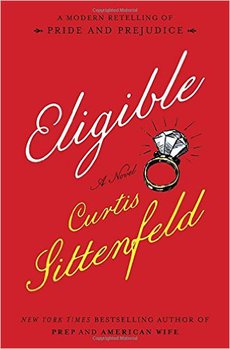
Eligible: A Modern Retelling of Pride and Prejudice
by Curtis Sittenfeld
Edna LewisReference Librarian
I love Curtis Sittenfeld’s writing (Prep, American Wife), and her modern retelling of Jane Austen’s Pride and Prejudice is hilariously current yet true to Austen’s themes of class, prejudice, money, and marriage. Set in Cincinnati, the Bennetts are an old money family who have run out of money with 5 adult daughters all unmarried.The two eldest, Jane and Liz, both approaching 40, have been working in NYC while the younger three (late 20s to mid 30s) still live at home without a thought for supporting themselves – Mary (antisocial and unfriendly who mysteriously disappears every Tuesday night), and Lydia and Kitty (Kardashian-like in their shallow self-centeredness). When Mr. Bennett suffers a major heart attack, Jane and Liz return home so that their mother (thoroughly annoying in a modern way with her provincial midwestern snobbery and addiction to online shopping and reality TV) can continue to chair her women’s club benefit. Yes, there is a Bingley with whom Jane falls in love, a Darcy who initially repels and then attracts Liz, a Wickham-like character who may not be what he seems, and an elopement by Lydia that results in Drama with a capital D. But Sittenfeld updates Austen’s story adding themes of gender identity, reality tv, racism, Silicon Valley, eating disorders, and single motherhood. Darcy, for example, went to Stanford and his family owns a huge estate in Atherton on Pemberley Lane. Yet the voice of this Liz is the voice of Austen’s Lizzie – a woman with a close connection to her father, the only one to truly understand and deal with her family’s money/inability to cope issues, and a woman who learns the hard way who is worth loving.
Eligible is the fourth book in a series in which contemporary authors have been asked to deliver modern retellings of Austen’s works - to date Alexander McCall Smith, Joanna Trollope and Val McDermid on Emma, Sense and Sensibility and Northanger Abbey, respectively.
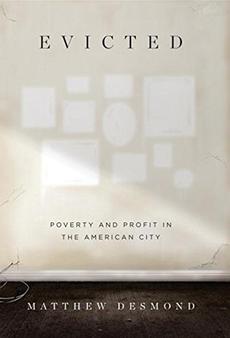
Evicted: Poverty and Profit in the American City
by Matthew Desmond
Michael LevyAssociate Director, Law Library; Lecturer in Residence
A book on eviction in the US might seem an unlikely recommendation for summer reading, but Desmond's work is a stunning ethnographic study of housing policies and practices and the nexus with poverty. Desmond, a professor at Harvard and recipient of a MacArthur "genius" award, looks at Milwaukee where he closely follows a series of renters and landlords as they navigate the economic realities of the rental market, and all too frequently the eviction courts in that city. This is far from a dry academic study as Desmond presents the human drama of poor renters from all racial groups struggling to make ends meet, and paying their monthly rent for oftentimes spectacularly sub-standard housing. The personal stories he presents are infuriating, eye-opening and heart breaking.
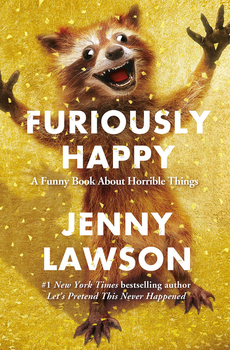
Furiously Happy
by Jenny Lawson
Ramona MartinezCirculation
If you’ve ever read http://thebloggess.com/ then you are familiar with this author. She struggles with mental illness, namely anxiety and depression, but she manages to write a blog that actually makes money, and this is her second best-selling book! A friend recommended I read this, and when I found it in the bookstore (Yes. A brick-and-mortar, independent bookstore!) I couldn’t possibly resist the cover. I have laughed out loud at several of her anecdotes and I will be incorporating some of her expressions into my daily vocabulary for sure. To give you an idea of her sense of humor, her two cats are named Ferris Mewler and Hunter S. Thomcat. You will marvel at the saint-like patience of her husband Victor who appears in her stories regularly. I happen to have read the chapter about her and Victor’s visit to the CPA to discuss tax planning on April 15 – a bit of serendipity I think. The list of some of her typical business expenses is hilarious, and you might relate to some of her strategies for saving receipts. I highly recommend Furiously Happy for your vacation reading. Be ready to explain what you’re laughing about to your fellow sunbathers.

Girl in the Dark
by Marian Pauw
Robert C. Berring, Jr.Walter Perry Johnson Professor of Law
This is the first work by Ms. Pauw, a successful Dutch author, to be translated into English. It is a powerful story told through two voices. Ray is in a facility for the mentally ill after having been convicted of a horrendous crime. Iris is a criminal lawyer who is edgy and prone to bad decisions. Each voice pulls you in and, inevitably, the stories intertwine. The prose reads in a very calm tone, maybe it is a feature of Dutch fiction as I always liked the work of Jan Willem van de Vettering for the same reason. There are a few graphic crimes committed, but they are off stage so there is little gore. I highly recommend this even to non-mystery fans. The voice of Ray is worth the price of admission. Beware there is another very different book with the same title.



Introducing the Honourable Phryne Fisher. Cocaine Blues; Flying Too High; Murder on the Ballarat Train
by Kerry Greenwood
William BenemannLibrary Archivist (ret.)
As viewers of PBS know, Phryne [FRY-nee] Fisher is the perfect heroine for a mystery series. After a hard-knock childhood in Melbourne, Australia that was overshadowed by the murder of her little sister, she fled to the Rive Gauche of Paris, where she became an artists’ model, and the mistress of a painter who was violently abusive. With the outbreak of World War I, she volunteered as a nurse and found herself near the front, up to her elbows in blood and gore. But her life changed dramatically when her ne’er-do-well black sheep father, upon the deaths of all his elder brothers in the war, inherited the family’s estate in England, a title, and a substantial fortune. Phyrne returned to Melbourne with a “Hon.” in front of her name, avant-garde tastes with the money to indulge them, and a nose for crime. Street smart, fearless, resourceful. She also has a liberal attitude towards sex that allows her to bed any number of interesting men — while gradually trying to seduce / falling in love with the reserved, by-the-book Detective Inspector Jack Robinson. Poison Pen Press has released a compendium of the first three Miss Fisher novels. The plots are fairly thin gruel, but in the same way that the television series’ sumptuous recreation of Jazz Age Australia is a feast for the eyes and ears, Kerry Greenwood’s lively and literate prose is a pleasure to read.

Johnny Tremain
by Esther Forbes (Ages 11-13)
Isaac Klein6th Grade, Fairmont Elementary School, El Cerrito
I am writing this book review on Johnny Tremain. It is by Esther Forbes. It is about a silversmith’s apprentice named Johnny Tremain. It takes place in Boston during the colonial times. Johnny is living with his master Mr. Lapham’s family and two other apprentices, Dove who is 18, and Dusty who is 11. While making a silver basin Johnny burns his hand, and can’t be a silversmith any more. Johnny sets out to find a new job. At the beginning of the story Johnny is proud and not humble but then he becomes more modest because of his burnt hand. He finds a printing office where he can work. He makes friends with the other apprentice Rab who happens to be a Son of Liberty. Johnny starts to meet new people such as Paul Revere, and John Adams. When the Sons of Liberty throw the tea into the harbor, British soldiers come to town. Then Rab joins Boston’s army, but Johnny doesn’t go with him. Suddenly Johnny hears that the British had 700 soldiers in the first fight and the minutemen only had 70. What Johnny doesn’t know is if Rab is dead or alive?
I would recommend this book for ages 11 and up because there are a lot of difficult words. I would rate this book 8 stars out of 10. I really liked towards the end of the book when Johnny got to meet all of the Sons of Liberty because Johnny got to meet all these famous people.
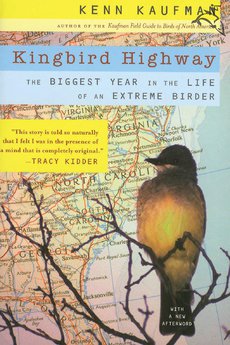

Kingbird Highway: The biggest year in the life of an extreme birder
by Kenn Kaufman
Lab Girl
by Hope Jahren
Chris TarrHead of Cataloging
Over the past month I’ve read two memoirs written by natural scientists, Kingbird Highway : The biggest year in the life of an extreme birder, by Kenn Kaufman, and Lab Girl, by Hope Jahren. Kaufman is the author of the well-regarded Kaufman Field Guide to the Birds of North America, and Jahren is a professor of geobiology at the University of Hawaii, doing research focused on living and fossil organisms and how they are chemically linked to the environment. Both of them, in different ways, are outsiders, and both of them attribute their success in no small part to their friends.
Kenn Kaufman was an honors student at a Wichita high school when he dropped out at 16 to roam the country in search of birds. Kingbird Highway is the story of the birds he saw, and how he grew up, from 1970-1973, just at the time that modern birding was born. “We were out to seek, to discover, to chase, to learn, to find as many different kinds of birds as possible . . .We became a community of birders, with the complications that human societies always have, and although it was the birds that had brought us together, our story became a human story after all.” (p. xi). If you are interested in birding, the book details how modern forms of communication, plus a bird guide, made it possible for birders to know which birds were where – something that had not been possible in the past, and that made it possible for people to start doing things like “big years,” where you try to see more birds than anyone else in a year. But if you are not, the story of how a kid grows up while crossing and recrossing the continent is worth a read as well. (If you’re a parent, you can only imagine how you would not have let him drop out of school to go birding, and yet, look how it turned out!)
Hope Jahren strikes me as a prickly person, and yet one has to imagine that were she not a prickly person, she would never have become a successful scientist and the head of a stable isotope geochemistry lab at the University of Hawaii. Again, the story is interesting even if you have never been that interested in plants – which, it turns out, are more fascinating than you might have thought. Much of the book focuses on Jahren’s friendship with the guy who ends up becoming her lab manager, Bill. It’s fascinating to read along while she becomes a scientist – we learn what it’s like to be a woman in science, in academia, as we watch her learning to think in new ways about plants. She seems like a prickly person, and maybe that’s why it’s a great read.

My Kitchen Year: 136 Recipes that Saved my Life
by Ruth Reichl
Nancy DonovanFSU
One day I will write the book I have been planning and threatening to write for decades: “I Always Feel Better After I Eat,” which was inspired by my friend Michael Mattor on his death bed. It is probably safe to say that almost everyone does feel better after they eat. Food and stories are staples of a good and meaningful life, and Ruth Reichl’s most recent book combines her fabulous storytelling, tweets and recipes to document how she survived the year after she was fired from Gourmet magazine in 2009. “My Kitchen Year” offers up wisdom for dealing with loss and life – with grit, humor and recipes.
And did I mention her tweets? Reichl’s tweets are often poetic, sensual and inspirational:
“The sexy sweetness of bay scallops. Such a fugitive flavor. So subtle. Raw. Sparked with shards of jalapeno. Showered with lime.”
“Electric Summer night. Wind in the trees. Smoke rising. Rare burgers. Sweet onions. Slaw. Righteous Rhone. Berries with cream. Friends.”
Yes, please! These are flavors and experiences I want to share.
Ruth Reichl has had a long and storied career in food and food writing, and it all started here in Berkeley in the 1970s. She’s an award winning memoirist, food writer, chef and editor, who worked at the New York Times, the Los Angeles Times, New West and Gourmet. My Kitchen Year, published in 2015, is her most recent book.
“The physical act of cooking gives me enormous pleasure,” Reichl writes, “but l also like watching what it does for others. . . . The formula is simple: when you cook for people, they feel cared for.”
Be inspired by Reich’s book; it’s full of gorgeous, simple pictures and unfussy recipes. Great food and good stories always make me feel better, improve your mood, sooth most any pain and comfort and entertain. This book would make a terrific summer read on the beach in Maui.
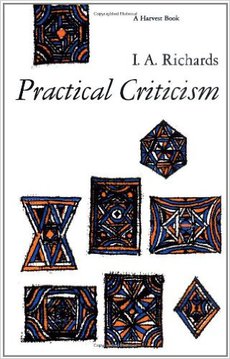
Practical Criticism: A Study of Literary Judgment
by I.A. Richards
Dean RowanDirector, Reference & Research Services
The influence of I.A. Richards on the study of English literature has barely waned since the first half of the twentieth century, when he was most active. While I don’t know whether these days one should reasonably expect to find him on the syllabus of an introductory literary theory course, surely the infamous so-called postmodern deconstructionists (as meaningless a phrase as one can fit into eight syllables) owe him a debt for focusing the reader’s attention on the text of a literary work to the near total exclusion of extra-textual factors, such as authorial biography or literary influence. Moreover, Practical Criticism is a pioneering work of empirical literary study conducted well before our present era of “big data.” Over several school terms Richards assigned his students poems stripped of identifying information, primarily title and author. He solicited evaluative responses, which he compiles, selects, and analyzes in the first half of the book. The object of his analysis is as much psychological as aesthetic. He detects the biases, misunderstandings, and outright failures-to-read his students demonstrate in their critical remarks, which he dubs “protocols.” His accompanying responses to the protocols alone are cutting and insightful. They teach us how to identify and address our own literary blind spots produced by a number of critical difficulties: making out the plain sense of the poem, responses to imagery, stock responses, and preconceptions about the value of poetry, among others. In the second half of the book, which I haven’t finished, Richards steps back to distill “morals” and “guiding threads” for the cultivation of literary judgment, drawn from his observations about student protocols. Most impressive, so far, is the approach to poetry Richards’ largely negative insights invite. We are accustomed to regarding a poem as a precious expression of an author’s deep and deliberate feelings, but also as fundamentally a historical artifact exhibiting evidence of the time and place in which it was spawned. In Practical Criticism Richards instructs us to bracket such expectations until we have given due attention to the impulses and clues proffered by the text itself.

The Raven Boys
by Maggie Stiefvater
Joseph CeraLegal Research Librarian for Information Technology & Scholarly Communications
This book combines a bit of Welsh mythology with normal young adult fiction themes. It's your classic story about taking chances, seeing ghosts, and searching for magic. The characters are well written and the story is entertaining. A girl named Blue is not a psychic but comes from a family of psychics. She meets four very different young gentlemen from the local private school and gets caught up in their hunt for a buried Welsh king. This is the first book in a series of at least 4 books. The series is a lot like the Hunger Games. The first book is so good that you want to keep reading the series but each subsequent book is just a bit less satisfying than the previous book. Eventually you read the entire series but it would have remained legendary if you had stopped after the first book. Choose that option here, if you can.

Roller Girl
by Victoria Jamieson (Grades 5-8)
Natalia Levy4th Grade, Peralta Elementary School, Oakland
The wonderful book Roller Girl by Victoria Jamieson is about a girl named Astrid who has a hard time with her friends in the summer. It all started when Astrid invited her best friend Nicole to a roller derby game. Astrid loved it, but Nicole thought it was too violent. Soon enough, they started not to like the same things. For example, Nicole likes to talk about boys, go shopping, and do ballet. Astrid likes Roller Derby, sports and likes looking different.
I think the theme of this book is that everyone is different and that is sometimes hard to deal with. For example, Nicole likes another girl named Rachel and doesn’t want to go to roller derby camp with Astrid. Astrid heard that Nicole was going to ballet camp, but Astrid doesn’t want to tell her mom because then she won't have a ride to roller derby camp. Another example is when Astrid wants to be jammer, the person on the roller derby team who scores all the points. But when the coach chooses who would be jammer her friend Zoey got to be it. Zoey was happy, but she got sad because she thought that Astrid wasn’t happy for her. But soon enough, the game was happening and Astrid tried to look for Zoey. Astrid found her in the bathroom. Zoey was nervous about the game, but Astrid cheered her up. They both apologize to each other, and they were friends again.
I like this book because the author writes about situations people can relate to. She does a great job describing what it feels like when a friend goes off and wants to do something else. I recommend this book because the author uses good examples of people having a hard time with their friends. For example, when Nicole went off with Rachel, Astrid didn’t know if she was still Nicole’s friend. Roller Girl does a good job coming up with solutions that can help a person get over these hard moments.

Seven Brief Lessons in Physics
by Carlo Rovelli
Kevin HickeyMicrosoft Research Fellow
About as elegant and lucid as a survey of modern physics theory can be. True to the title, this book is very short, just shy of 100 pages. In that space it manages to beautifully illustrate the core ideas and intuition behind relativity, quantum mechanics, the standard model, and cosmology. Especially interesting is the chapter on quantum gravity, a non-string-theoretical attempt to unify relativity and the standard model. It is a quick, pleasurable read even if this is familiar material, as Mr. Rovelli has a knack for clever illustrations of fundamentally abstract concepts. He is especially deft at conveying how truly odd the physical world is at large and small scales.
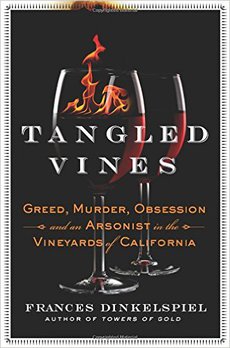
Tangled Vines: Greed, Murder, Obsession, and an Arsonist in the Vineyards of California
by Frances Dinkelspiel
Marci HoffmanAssociate Director & International and Foreign Law Collections
Whether you like to drink wine or not, this is a good read. The title makes it sound like a novel, but it’s actually nonfiction. Basically, it’s about greed of one person in particular, the murders of a couple of people (not associated with the greed of that person), obsession (over wine, money) and a devastating fire that occurred in a wine warehouse in Vallejo. Part of the book’s focus is on the arsonist, Mark Anderson, a rather unlikeable fellow who charmed and bilked a lot of people. In great measure, he represents the greed. He is currently serving a 27-year federal prison sentence and not just for the fire, he concocted a large-scale wine embezzlement scheme. The 19-count indictment included arson, interstate transportation of fraudulently obtained property, mail fraud, use of a false name and tax evasion. The fire resulted because he was trying to hide the evidence of his greed and in the process he destroyed between 4.5 million and 6 million bottles of wine worth more than $250 million!! The fire had an enormous impact on many Napa wine makers who were housing their wine at the facility. Some wineries lost thousands of bottles of wine and their wine libraries were wiped out.
Some of the wine destroyed included 175 bottles of Angelica and Port-style wines from the 1875 Cucamonga Vineyard, which was made by the authors’ great-great grandfather, Isaias Hellman. Therefore, the book recounts the history of this vineyard and the people involved – it’s quite a tale. In telling this part of the story, Dinkelspiel provide a good bid of the history of wine and winemaking in California. This history also includes greed, murder and much more (racism, collusion, shady deals, etc.).
It’s a quick read, not too technical, and it’s pretty interesting. Even if you are not a fan of wine, Mark Anderson is a pretty loathsome guy and that always makes for fun reading! Dinkelspiel is a local writer and she co-founded the Berkeleyside website.
Another good read about wine is Napa: The Story of an American Eden (2002) by James Conaway.
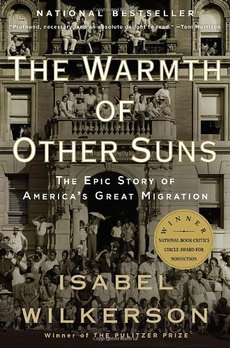
The Warmth of Other Suns: The Epic Story of America's Great Migration
by Isabel Wilkerson
Kevin HickeyMicrosoft Research Fellow
This book won the Pulitzer Prize in 2011, but I finally got around to reading it this year. The Warmth of Other Suns seems likely to become the definitive historical account of the Great Migration, the movement of millions of African Americans from the rural south to northern cities over the better part of the 20th century. All the awards and acclaim are well deserved. Despite its historical and physical heft (it is about 700 pages, the product of a decade's worth of research and interviews with over a thousand people), the book is very engaging. Ms. Wilkerson primarily focuses on the stories of 3 individual migrants, carefully selected to represent different eras and destinations of the migration. These compelling individual stories are interspersed with chapters focusing on the related experiences of other migrants and of the history of the migration from a larger historical and social perspective. A terrific way to learn about one of the largest movements of people in history, and its impact on American cities and society.